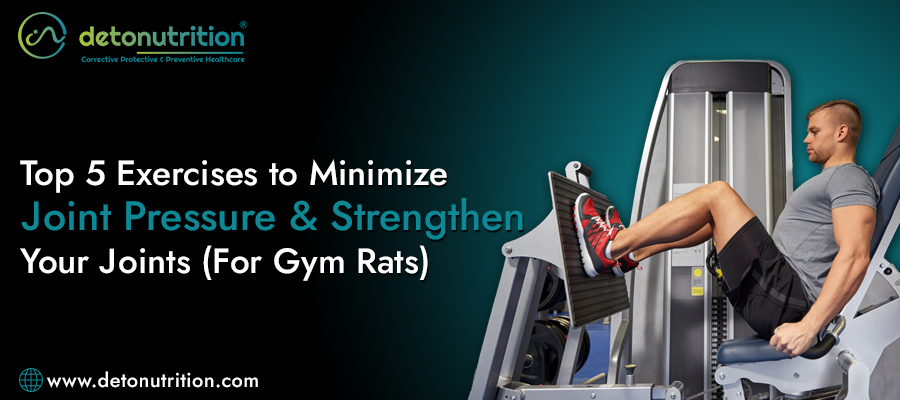Top 5 Exercises To Minimize Joint Pressure & Strengthen Your Joints (For Gym Rats)
Do your knees or elbows hurt and your back feels stiff after your workout session? Don't worry, you're not alone! Many people think that using improper form while exercising will later hurt their joints which is correct but not always improper form hurts you. Doing exercise in proper form can allows you to target the right muscles. But smoking, not eating healthy diet and taking dietary supplements cause joint pain. Lots of people even in their 20’s or 30’s have joint pain. But guess what? We have something for you that help your joints to become strong and reduce joint pressure. Read on to know the best exercises that will make your joints stronger and ways to minimize joint pressure and feel better.
Read This Article - What Are The Causes Of Joint Pain And How To Cure It?
Why Having Strong Joints Are Crucial For Overall Wellbeing?
Strong joints are like superheroes for your body! They help you run, jump, and play without getting hurt. Just like you need strong muscles to lift heavy things, you need strong joints to move your body smoothly.
Here’ a detailed guide to the top 5 exercises to minimise joint pressure and strengthen your joints, ideal for gym rats:
1. Exercises using Isometry
During isometric workouts, muscles are contracted without causing joint movement. Without placing strain on the joints themselves, they aid in strengthening the muscles around them. For those who are trying to avoid joint injuries or who are experiencing joint discomfort, isometric exercises are great.
Here Are Three Isometric Exercises That You Can Try:
-
Isometric chest press
To do an isometric chest press, face the wall and set your palms shoulder height and approximately 6 inches away from your chest. For ten to fifteen seconds, firmly press your palms onto the wall while maintaining your core. Do this three times and repeat if comfortable.
-
Isometric shoulder press
Put your arms back toward the wall with straight elbows for ten repetitions while standing with your back to a wall and contracting your core. Keep your back straight and your shoulders low throughout the movement. Repeat for 2-3 sets.
-
Isometric leg press
Sit or lie down with your back supported. Extend your legs out in front of you and tighten your thigh muscles as hard as you can for 15 reps. Repeat this exercise twice or thrice daily to strengthen the muscles around your knees.
2. Ankle and Knee Mobility Exercises
Good ankle and knee mobility contributes to better balance, fewer falls, and improved performance in exercises like squats and deadlifts. Improving both ankle and knee mobility can also help prevent ankle sprains and other ankle injuries.
How To Do It:
- Stand next to a wall, place your hands on the wall for support.
- Keeping your heels on the ground, slowly forward onto your toes, feeling a stretch in your calves.
- Slowly get back onto your heels, lifting your toes off the ground.
- Repeat this motion 10 times, making sure to keep your knees soft and your core engaged throughout the movement.
Read This Article - 10 Ways To Improve Your Joint Health While Exercising
3. Hip Mobility Exercises
The hip joint is a ball and socket that moves in all directions. Warming up the hips and surrounding muscles is the key before any workout to prevent hip injuries and improve performance in exercises like squats, lunges, and deadlifts.
How To Do It:
- Stand with your feet hip-width apart, place your feet firmly on the ground.
- Lift your left knee, keeping your knee bent at a 90-degree angle.
- Make a circle with your left knee, moving it out to the side and then down towards the ground.
- Repeat this circling motion 10 times, then switch directions and repeat with your right leg.
- Make sure to keep your core engaged and your hips square throughout the movement.
4. Thoracic Spine Mobility
A Good thoracic spine mobility allows free arm movement overhead and side-to-side turning. Poor mobility can lead to shoulder pain, poor posture, and upper back pain. Improving thoracic spine mobility can also help prevent injuries in exercises like overhead presses and pull-ups. It also improves posture, facilitates better breathing, reduces back pain, increases range of motion, and enhances athletic performance. There are various thoracic spine mobility exercises cat cow, spinal roll, child's pose with arm reach, cat-camel, deep squat with thoracic rotation, thread the needle, downward dog pose etc.
How To Do It:
Here’s How You Do Child's Pose With Arm Reach
- Kneel on the floor and sit back on your heels
- Extend your arms forward and rest your forehead on the ground.
- Slowly reach one arm forward and then the other, opening up your chest.
5. Shoulder Mobility
Poor posture can cause tightness through the chest and front of the shoulders. Warming up the shoulders before a workout improves form and prevents injury. Improving shoulder mobility can also help prevent shoulder injuries and improve performance in exercises like bench presses and pull-ups. Check out wall slides exercise for better shoulder mobility.
How To Do It:
- Stand with your back against a wall, feet shoulder-width apart.
- Press your lower back, buttocks, and head against the wall.
- Raise your arms to your sides, forming a 90-degree angle at the elbows, with your palms facing forward.
- Slowly slide your arms up the wall as high as you can without losing contact with the wall or arching your back.
- Hold the top position for a few seconds, then slowly slide your arms back down to the starting position.
- Repeat 10-15 times.
Other bonus exercises to strengthen your joints include resistance band exercises, body weight squats, swimming, plank and pull-ups.
Remember: Don’t forget to incorporate a dynamic warm-up with these joint mobility exercises for at least 10 minutes before your workout. This will improve flexibility, range of motion, and joint function so you can train harder with less risk of injury. Remember to listen to your body and stop immediately if you feel any sudden pain or discomfort. Always begin with low-impact exercises, maintain a healthy weight, eat healthy balanced diet along with organic supplements for joint health, stay hydrated and take enough sleep for better overall health.
Read This Article - Top 5 Workout Mistakes That Lead To Joint Pain And Tips To Avoid
Conclusion
Strengthening your joints and minimizing its pressure is crucial for long-term gym success and injury prevention. By incorporating these five exercises into your routine and taking proactive steps to minimize joint pressure, enhance stability, and improve overall performance. However, it's essential to listen to your body and avoid pushing through pain. If you experience persistent discomfort, consult with a healthcare professional. By prioritizing joint health, you'll not only protect yourself from injuries but also continue to make progress in your fitness journey.

We have a vision to take good care of your health and nutrition with products which are made from research and experience. Our team is technical as well as experienced so that we can deliver you the best products for your health and wellness.
Stay Fit, Stay Healthy And Stay Happy Always!
QUICK LINKS
CATEGORIES
Subscribe Us
Subscribe to Dr. Aaditya's Health Blog Email Newsletter
© Copyright - Detonutrition. All Right Reserved 2025.




